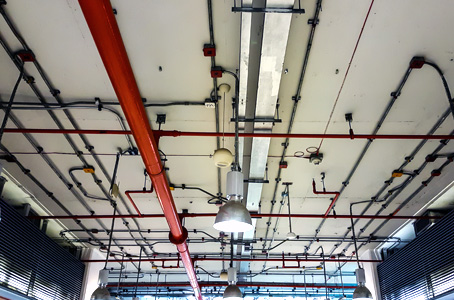Fire Detection & Gas Suppression Systems
Addressable Smoke Detection Systems
An addressable smoke detection system is one in which all fire and smoke detection devices in a system are connected and communicate both with each other and the main fire control panel. This interconnectivity allows the identification of the device’s location or address.
Every device connected to the addressable system has its own unique identifier/address. When a fire or fault is detected, the device’s address will show up on the fire control panel display. Thus identifying a fault or fire and providing the quickest methods of addressing extinguishment.
Conventional Smoke Detection Systems
A conventional system is a fire alarm that identifies the activated smoke detector or manual call point by a zone LED display. A conventional smoke detection system consists of zones. Every zone comprises multiple initiating and notification devices, which are then linked to the conventional fire control panel. Conventional systems are analog in that they use electrical currents to communicate with the main fire control panel.
Beam Detection Systems
An optical beam smoke detector is a device that uses a projected beam of light to detect smoke over large areas, typically as an indicator of fire. They are used in buildings where standard point type detectors are not economical or restricted due to the building’s height.
Early Warning High Sensitivity Systems
Also known as aspirating smoke detection systems, early warning high-sensitivity systems are used in active fire protection, consisting of a central detection unit that draws air through a network of pipes to detect smoke. The air sample then passes through a dual-stage filter. The first stage removes dust and dirt from the air sample before it enters the laser detection chamber, thus identifying the presence of smoke and potential fire.
In Cabinet Smoke Detection Systems
Aspirating smoke detection is used to monitor smoke detection inside MCC cabinets and Server room cabinets. A network of pipes is run above the cabinets, with capillaries installed above the cabinets used to sample the cabinet’s air.
The air inside the cabinet is sampled through the dual-stage filter. The first stage removes the dust and dirt from the air sample before it enters the laser detection chamber, which detects smoke and alerts to potential fires.
IR Flame Detection Systems
A flame detector is a sensor designed to detect and respond to the presence of a flame or fire. Responses to a detected flame depend on the installation of the system. The flame detector can trigger the fire alarm or deactivate a fuel line and trigger a gas suppression or foam suppression system.
The sensors of the flame detector operate via an infrared band. A small thermal imaging camera installed inside the detectors can instantly detect hot gasses released anywhere near the flame detector. Infrared waves can penetrate dust, fuel particles, and oil films.



Gas Suppression Systems
Gas suppression systems are used to extinguish, control, or in some cases, entirely prevent fires from spreading or occurring.
Gas suppression systems have an incredibly large variety of applications, and as such, are designed for every type of business, building, and fire contingency possible.
All our gas suppression systems are designed to ensure that any area of coverage is protected – however large or small.
Our qualified fire technicians are able to design, supply, install and maintain all types of gas suppression systems.
Types of gas suppression systems include:
- FM 200
- Pyrogen In-Cabinet Protection
- Inergen
- Novec
- Argonite
- CO2
- Pyroshield
- Stat-X In-Cabinet Protection